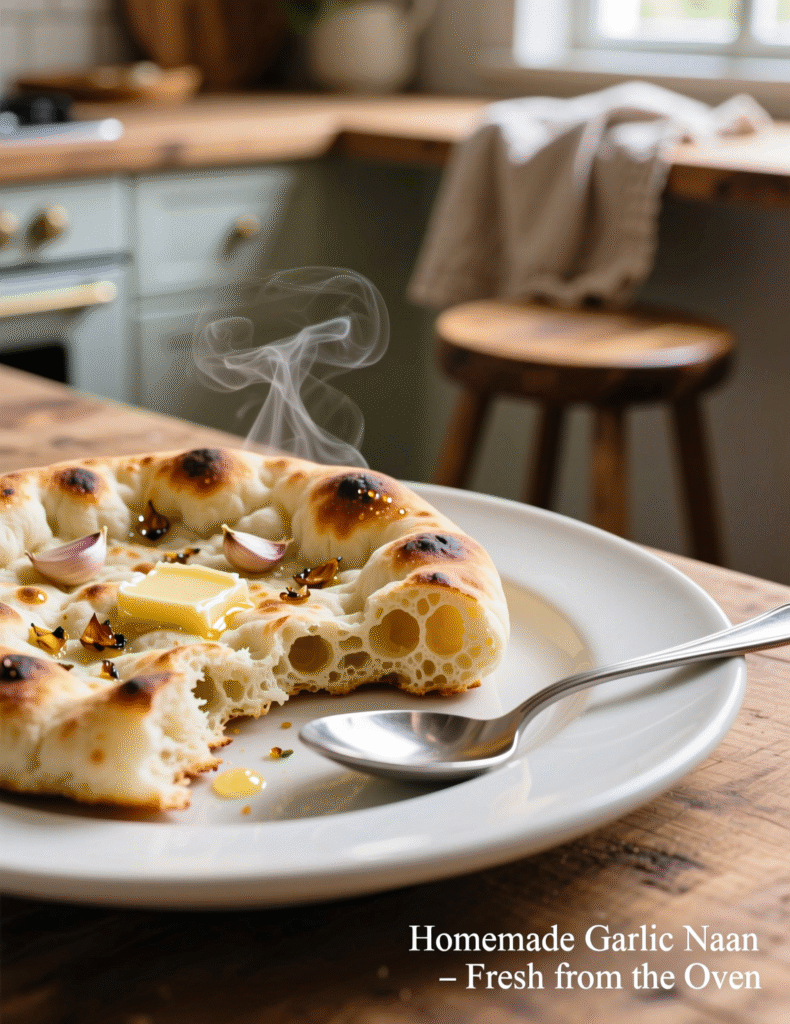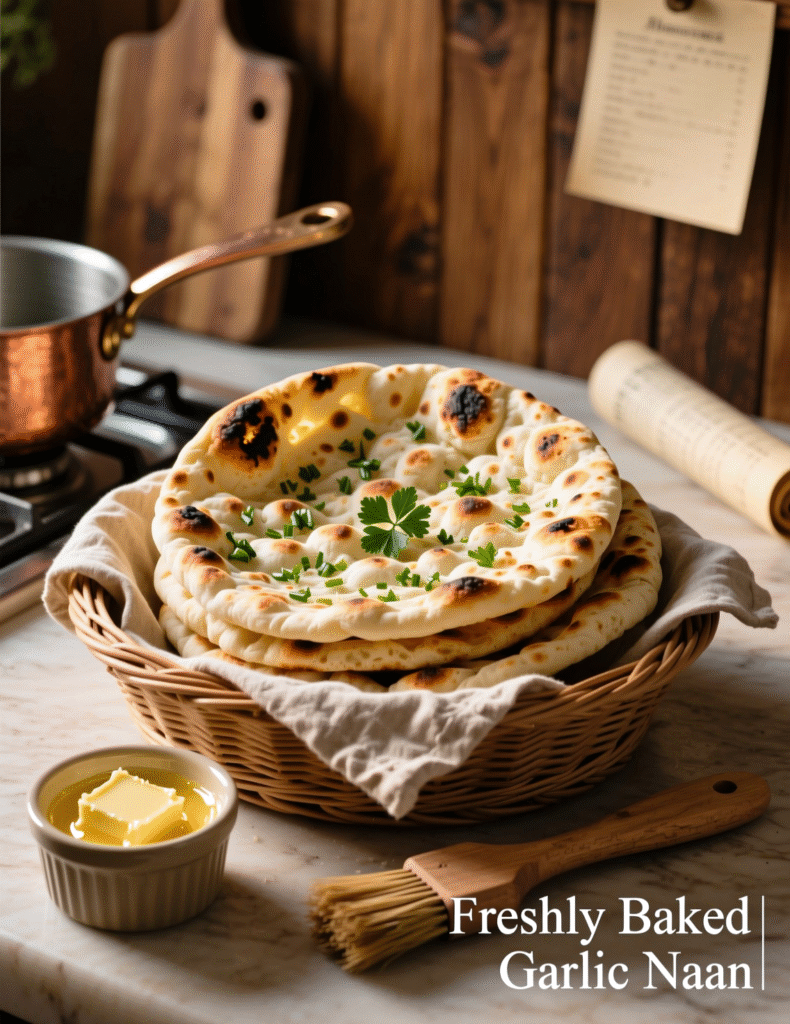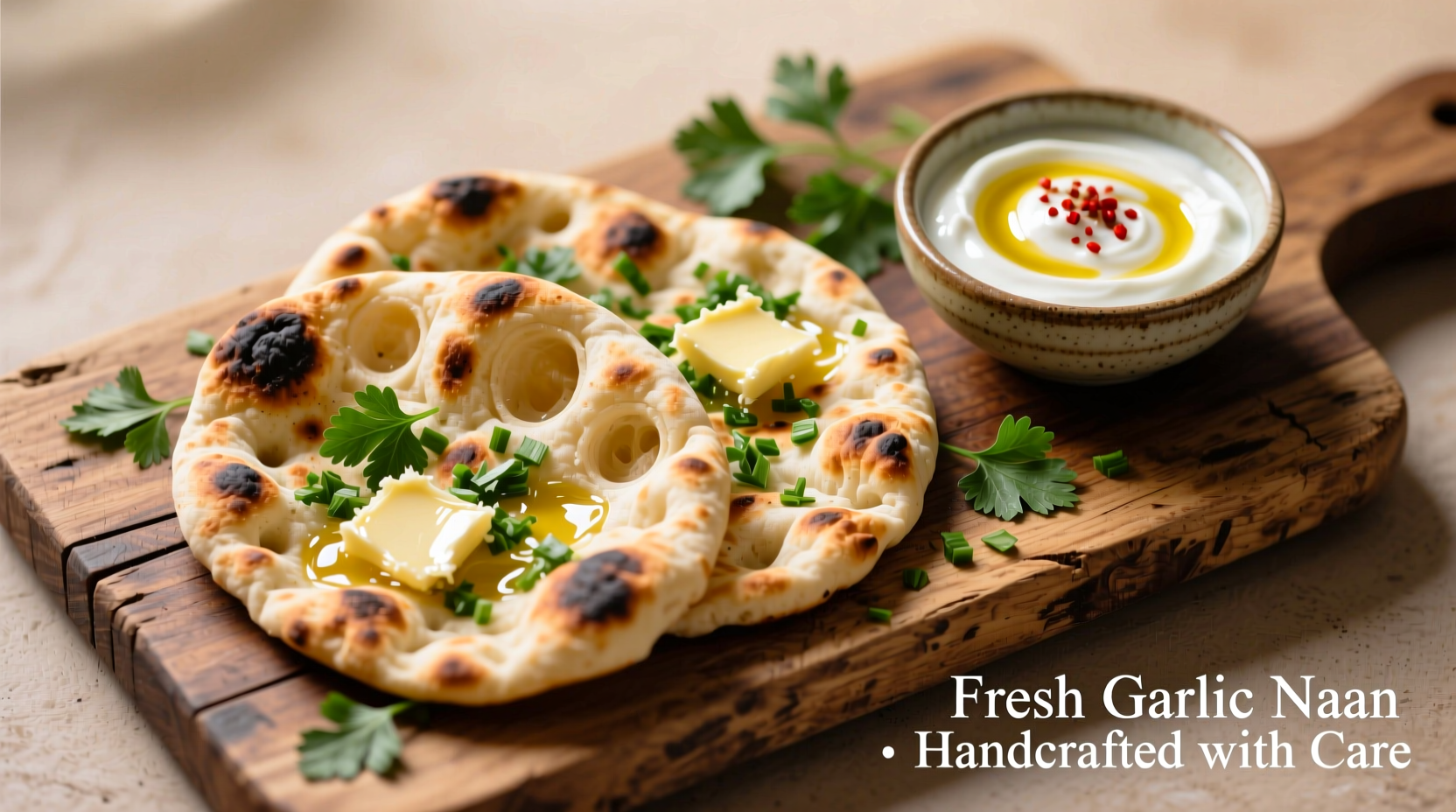If you’ve ever sat in an Indian restaurant, tearing apart a piece of pillowy garlic naan, you’ve probably wondered how hard it is to recreate at home. Spoiler—it’s not rocket science, but it’s not just slapping dough on a pan either. Making a truly good naan, the kind that bubbles and blisters, needs technique, balance, and a few secrets that chefs rarely mention out loud. This guide isn’t just another recipe—it’s an expert walkthrough on how to get naan right, every single time.
Why Garlic Naan Deserves More Attention
Garlic naan bread isn’t just flatbread. It’s a cultural staple that’s traveled from Indian kitchens to global restaurant tables. In 2023, a report by Mordor Intelligence showed that demand for Indian-style breads in global frozen food markets increased by over 8% annually. That growth is led mainly by naan. Garlic naan, in particular, is the crown jewel because it blends subtle char, soft chew, and aromatic garlic butter that lingers on the palate.
Chefs often treat naan as a sidekick to curries, but truthfully, a perfectly made naan can outshine the main dish. I’ve seen customers order three extra baskets before finishing their butter chicken. That’s the power of bread done right.
The Science Behind Naan Dough
Good naan dough is a living thing. It’s not as dense as pizza dough, nor as airy as ciabatta. It sits in a sweet spot, where gluten development matters but tenderness is equally vital. The classic formula uses all-purpose flour, yogurt, and yeast. Yogurt, here, isn’t a gimmick—it’s a tenderizer. Lactic acid in yogurt softens the gluten strands, which gives naan its signature chew without toughness.
Professional kitchens in Delhi often rest the dough longer than home recipes suggest. While most home guides call for 1 hour, restaurants give it 3–4 hours of bulk fermentation. This extended time lets yeast produce more flavor compounds—esters and alcohols—that subtly enhance taste.

Ingredients That Make or Break It
For an easy garlic naan bread recipe that still carries professional weight, you’ll want:
- Flour (500 g, all-purpose) – protein content around 11% works best.
- Instant yeast (7 g) – more predictable than active dry.
- Sugar (10 g) – not just for yeast but for browning.
- Salt (10 g) – balances flavors.
- Yogurt (100 g, plain, full-fat) – never skip this.
- Milk (120 ml, lukewarm) – helps tenderness.
- Oil (30 ml, neutral) – sunflower or canola, not olive.
- Garlic (4–5 cloves, finely minced) – fresh, not jarred paste.
- Butter (60 g, melted) – to brush after cooking.
- Cilantro (optional, handful chopped) – adds freshness.
Every professional knows one truth—ingredients don’t forgive. If you skimp on yogurt or use low-quality garlic, the bread shows it.
Step-by-Step: Crafting Naan Dough
Mixing
Combine flour, yeast, sugar, and salt in a large bowl. Add yogurt, milk, and oil. Mix until shaggy. Dough at this stage looks messy, sticky, even wrong—but that’s exactly where it should be.
Kneading
Knead on a lightly floured surface for 8–10 minutes. You want smooth, slightly tacky dough. Too dry, and naan turns leathery. Too wet, and it won’t roll cleanly. Professionals rely on “the poke test”—press your finger into the dough; if it springs halfway back, gluten is developed enough.
First Rise
Cover with a damp cloth and rest for at least 90 minutes. Some chefs in Mumbai kitchens proof near hot tandoors for steady warmth, but in a home kitchen, an oven with the light on works fine.
Dividing
Punch down, divide into 8 equal pieces. Roll each into a ball. Let them rest again, 10–15 minutes. This second rest relaxes gluten, so rolling later doesn’t feel like fighting elastic rubber.
Shaping and Cooking Garlic Naan
Rolling naan is an art. Professionals rarely use a rolling pin. Instead, they stretch dough with fingers and palms, letting gravity do part of the work. Home cooks can roll with a pin, but avoid making it too thin. Thickness affects pocketing of air bubbles—the soul of naan.
Traditionally, naan bakes in a tandoor oven at around 900°F. Dough slaps against the clay wall, sticks, and cooks in less than 90 seconds. Homes don’t have that luxury. But cast iron skillets get close. Heat a skillet until smoking, place rolled dough, cook 1–2 minutes until bubbles form, then flip. Cover briefly with a lid to trap steam and puff it further.
Garlic Butter Infusion
Garlic naan earns its name not just from dough but the post-cook treatment. Melt butter, stir in fresh minced garlic, and brush generously over hot naan. The heat blooms the garlic aroma without burning. Some chefs also char whole garlic cloves directly on flame, crush them into butter, and brush for deeper flavor. Try both, see which suits your table better.
Sprinkle cilantro or parsley if desired. Serve immediately—naan loses its magic as it cools.
Common Mistakes (and How Pros Avoid Them)
- Using cold yogurt: it shocks yeast, slowing fermentation.
- Rolling too thin: naan turns into crisp crackers.
- Cooking on low heat: dough dries before puffing.
- Adding garlic directly to dough: garlic releases sulfur compounds that weaken gluten, resulting in flat bread. Always apply after.
One chef in London told me he ruined 30 batches before realizing raw garlic inside dough was sabotaging the structure. Painful, but memorable.

Professional Variations
Garlic naan is a canvas. Professional kitchens spin countless variations:
- Cheese-stuffed naan – mozzarella or paneer tucked inside.
- Chili-garlic naan – minced green chilies mixed with garlic butter.
- Black garlic naan – modern trend, adding sweet umami punch.
- Whole wheat naan – healthier, though trickier to keep soft.
Data from the Indian Restaurant Association in 2022 showed garlic-cheese naan was among top 5 ordered breads across UK Indian restaurants. Customers increasingly want indulgent twists.
Pairing Garlic Naan Like a Pro
Classic pairings include butter chicken, saag paneer, or lamb rogan josh. But naan isn’t limited to Indian food. Professional chefs experiment—garlic naan as pizza crust, as wrap for kebabs, even alongside Middle Eastern dips like hummus. A Michelin-starred restaurant in New York serves naan with caviar and crème fraîche, blending cultures in one bite. Unorthodox, but it works.
Trends in Naan Consumption
The frozen naan market has exploded. According to Grand View Research, global frozen bread sales crossed $20 billion in 2024, with naan contributing significantly. Garlic naan, with its universal appeal, leads flavor categories. Convenience drives sales, but experts note quality still lacks compared to fresh.
Restaurants are now installing custom gas-fired naan ovens, bridging the gap between traditional tandoors and modern kitchens. Expect to see naan on more menus outside Indian cuisine in the coming decade.
Troubleshooting Guide for Professionals
- Naan too dense → dough under-proofed. Extend rise.
- Burnt spots without puff → pan too hot. Lower heat slightly.
- No blistering → dough rolled too thick. Adjust thickness.
- Chewy but tough → over-kneading or low-fat yogurt.
Professional kitchens rely on trial, error, and sensory experience. Dough isn’t numbers—it’s feel. Trust your hands as much as scales.
Final Thoughts on Garlic Naan
Making garlic naan at home isn’t just about following steps—it’s about respecting a tradition while applying professional know-how. The best naan carries balance: smoky char, airy pockets, buttery garlic perfume. When done right, it becomes more than bread—it’s an experience.
For professionals, the key lies in fermentation control, heat management, and timing. For home cooks, it’s about not being afraid of messy dough and high heat. Either way, garlic naan reminds us why simple breads can command such devotion worldwide.
Now the only real question—do you make one batch, or two, knowing the first basket vanishes before dinner starts?
FAQs
What is garlic naan bread?
Garlic naan is a soft, fluffy Indian flatbread flavored with garlic and brushed with butter.
Can I make garlic naan at home without a tandoor?
Yes, a hot cast iron skillet or oven works perfectly for home cooking.
Why is yogurt added to naan dough?
Yogurt tenderizes gluten and gives naan its soft, chewy texture.
How long should naan dough rise?
At least 90 minutes for bulk fermentation, longer if possible for better flavor.
Can I add garlic directly to the dough?
No, adding garlic post-cooking preserves dough structure and flavor.
What’s the ideal thickness for rolling naan?
About ¼ inch; too thin makes it crisp, too thick prevents puffing.
How do I get the characteristic bubbles on naan?
Cook on high heat and let steam trap under a lid for a few seconds.
Can I freeze garlic naan?
Yes, naan freezes well; reheat in a skillet or oven for best results.
What are popular variations of garlic naan?
Cheese-stuffed, chili-garlic, whole wheat, and black garlic versions are common.
What dishes pair best with garlic naan?
Curries like butter chicken, saag paneer, lamb rogan josh, or dips like hummus.

Mariana is a passionate home cook who creates delicious, easy-to-follow recipes for busy people. From energizing breakfasts to satisfying dinners and indulgent desserts, her dishes are designed to fuel both your body and hustle.
When she’s not in the kitchen, she’s exploring new flavors and dreaming up her next recipe to share with the Foodie Hustle community.

